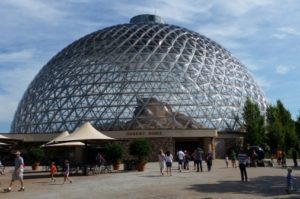
Overall Rating![]()
The Henry Doorly Zoo was founded in 1894 and is located in Omaha, Nebraska. The Zoo is home to over 17,000 animals over 130 acres. 7 acres of the Zoo is dedicated to indoor exhibits. The Zoo is an accredited member of the Association of Zoos and Aquariums and participates in the AZA program called the Species Survival Plan. There are 2 main exhibit buildings. The Desert Dome which includes a basement that houses Nocturnal animals. Then there is the Jungle Building. This building is home to the Rainforest and the animals that inhabit the Rainforest.
Henry Doorly Zoo Website: www.omahazoo.com
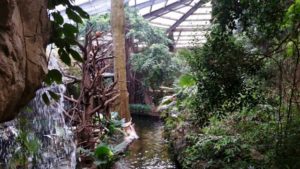
Hours:
Summer
(March 15-October 31)
9:00AM – 5:00PM
Winter
(November 1 – March 14)
10:00AM – 4:00PM
Ticket Pricing:
Spring & Fall (March 15-April 30) (October 1-October 31)
Adults (12+)-$20.95
Seniors (65+)-$19.95
Kids (3-11)-$13.95
Military Adult (12+)-$19.95
Military Kid (3-11)-$12.95
Kids 2 & under-Free
Summer (May 1-September 30)
Adults (12+)-$24.95
Seniors (65+)-$23.95
Kids (3-11)-$17.95
Military Adult (12+)-$23.95
Military Kids (3-11)-$16.95
Kids 2 & under-Free

Winter (January 1-March 14) (November 1-December 31)
Adults (12+)-$16.95
Senior (65+)-$15.95
Kids (3-11)-$10.95
Military Adult (12+)-$15.95
Military Kids (3-11)-$9.95
Kids 2 & under-Free
Parking: Free
Pet Daycare:
Limited kennel services
For more information call Guest Services 402-733-8401
Restaurants:
The Zoo has 3 seasonal restaurants/concessions available for patrons.
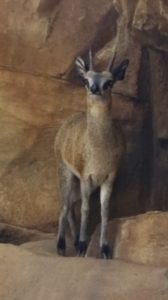
Animal Habitats![]()
Education![]()
Cultural Immersion![]()
Navigation![]()
Food Variety![]()
Click here to check out how we rate our categories.
Our Zoo Experience
This is one of my favorite zoos to visit and I can’t wait to go back soon. Since the zoo is a staggering 130 acres, with 7 of those acres being indoor exhibits, we made this zoo a two day Adventure.
It was awesome! Keep in mind this zoo is a bit expensive, but completely worth it. Steve and I purchased a zoo membership with our local zoo. We found out most of the zoos we visit have a reciprocal relationship with our local zoo.
So here’s how it works. We bought a zoo membership for our local zoo costing us $50.00 for a year. This membership allows me and one guest to visit our zoo as much as we want over the year (we do have to renew once a year). We then get a discount at many of the zoos we visit, if they reciprocate.
Henry Doorly Zoo gives a 50% discount on admission with our local zoo membership. You do have to have your membership card present. Most zoos websites have a list of zoos they are reciprocal with.
We always check to see if the zoo we are visiting honors the membership reciprocation. This is why we were ok visiting the zoo over the course of two days.
We arrived at the zoo at 9 am when they open. We were there the first week of August. The temperature wasn’t terribly hot, but we did work up a bit of a sweat on the Africa trek. We were also glad we brought our sunscreen.
Let’s start with what we did on day one. When we entered the zoo, the first thing we did was looked at the map. We decided what we were going to do that day, and what we would come back and do the next day.
We decided we would stick to the front part of the zoo the first day. The next day we would see all of Africa. The first building we went into was the Desert Dome.

The Desert Dome is exactly what it sounds like. The Desert Dome is the world’s largest indoor desert. There is approx. 84,000 square feet on two levels. 42,000 square feet of habitats on each level. It is a massive building, inside are three different deserts represented.
The Namib Desert; the world’s oldest and most biologically diverse desert, Australia’s Red Center, and the Sonoran Desert (Southwest United States) can all be found on the first level (ground level).
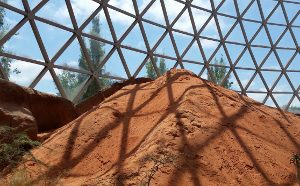
On the second floor (down stairs) is the exhibit Kingdom’s of the Night, the world’s largest nocturnal exhibit.
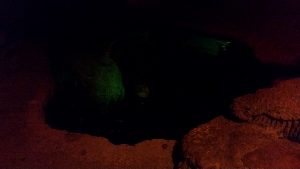
Let’s start above ground on the first level, in the deserts. This exhibit takes you around the world. You will encounter the animal species which inhabit those deserts.
As you walk in you see this massive mound of red sand. The first desert represented is the Namib Desert. It features a 30 foot sand dune containing 300 tons of red sand.

The species you encounter first, which call this desert home, are the Klipspringer, Meerkats, and Bat-eared Fox. The Klipspringer is a small even-toed ungulate, which live in steep, mountainous terrain.
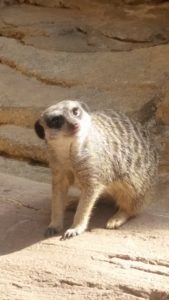
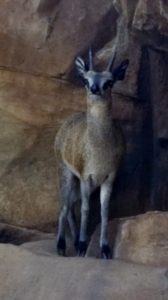
As you wind your way through to the next desert, you will encounter a few different species of snake from Africa; some venomous.
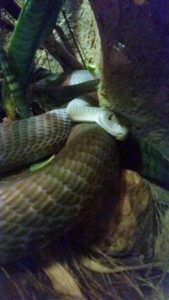
The next desert is the Red Center of Australia. It is one of the most isolated deserts.
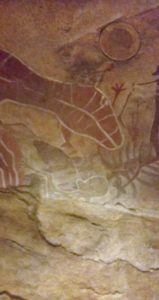
Here, you can see Rock Wallaby; you have to look up though if you want to see them. Their habitat is about 20 feet up on the side of a rock wall.
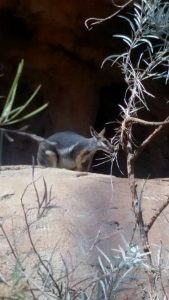
Some other species in the Red Center include Death Adders, Inland Taipan (world’s most venomous snake), and Laughing Kookaburras.
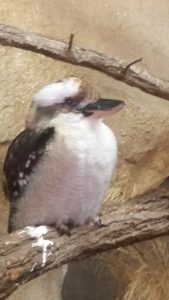
The last desert you travel to, is here in the United States, the Sonoran Desert. This is the world’s second most biologically diverse desert.
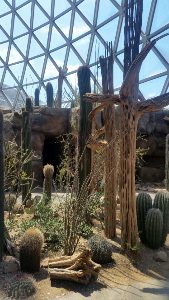
Here you can find Ocelot, Collared Peccary, Burrowing Owls, Bobcat, Turkey Vulture, Iguana, and lots and lots of Rattlesnakes.
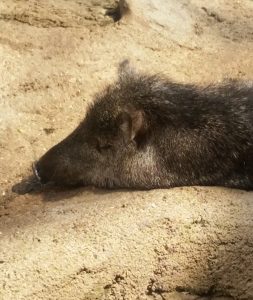
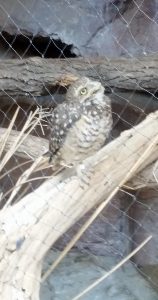
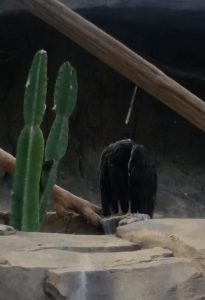
They have the largest Rattlesnake habitat I have ever seen in a zoo.
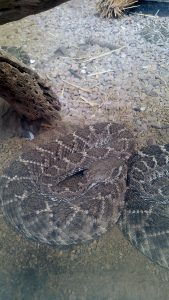
The habitat is set up to look like an old mine shaft in the desert mountains.

Fourteen species of reptile and amphibians are found in the Sonoran Desert exhibit. Oh and don’t forget the cutest Coati, living among the rocks.
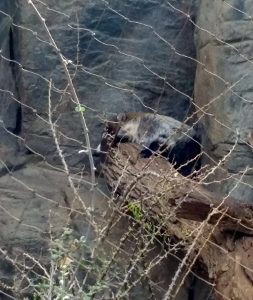
As you exit the deserts you can take the stairs or elevator down to see Kingdom’s of the Night (nocturnal species exhibit).

Here the zoo has reversed the day-night cycles of the animals. This allows you to experience the different species in their natural nocturnal activity.
The Kingdom’s of the Night exhibit spans ¾ of an acre. Like the deserts above the Kingdom’s of the Night is divided into several habitats. Each habitat represents a different environment.
The Canyon features Naked Mole Rats, Fossa, and Bats. This leads to an African Baobab Tree (upside down tree). Here you can see the transition from sun up (dawn) to sun down (dusk).
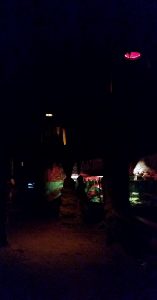
Some of the species here include Aardvark (adorable), Springhaas (think giant jumping rat/rabbit), and Greater Bush Babies (they have giant eyes enabling them to see in the dark).
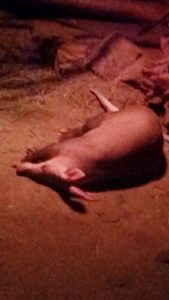
When you enter the Eucalyptus Forest next, be prepared to face Wallabies, Echidna (like a hedgehog but bigger and from Australia), and Freshwater Crocodiles.
Echidna are Monotremes, which means they lay eggs, and they also have mammary glands.
Under the Desert Dome is also the world’s largest indoor swamp. It holds 160,000 gallons of water with ¼ acre of boardwalk above the swamp. In the swamp you can encounter Nutria, American Beaver, and nine American Alligators.
This building along with the Lied Jungle will take you a while to get through. Now let us talk about the Lied Jungle. It is located on the other side (right) of the Wild Kingdom Pavilion.
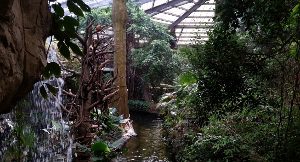
The Desert Dome (FYI) is on the left, but honestly with the massive dome, you can’t miss it. Anyway, the Lied Jungle is America’s largest indoor jungle. This building is also a two story building, and it takes you on a journey from the jungle’s canopy to the jungle’s understory (or vice versa).
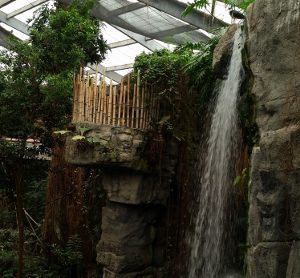
There are stairs, winding pathways, and an elevator to help you get from top to bottom or bottom to top.
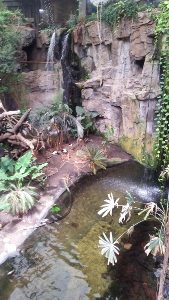
In the Lied Jungle you can encounter species such as White-handed Gibbons, Malayan Tapirs, Macaws, Pygmy Hippo, Turtles, Giant Fish, and many more. The jungle has species from rainforests around the world, from South American, Asia, and Africa.
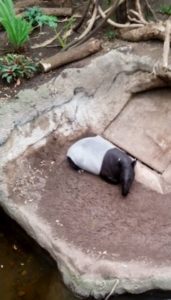
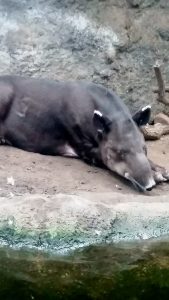
When we walked into the jungle, we were above in the canopy. Looking down we saw a river with all sorts of animals. Turtles, Tapir, Pygmy Hippo, and huge I mean HUGE Arapaima (a species of fish).
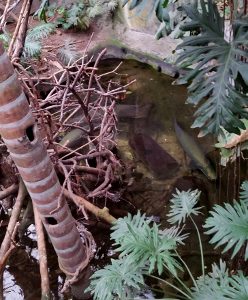
In the canopy, besides all the exotic rainforest birds, we saw White-handed Gibbon on a huge tree in the middle of the river.
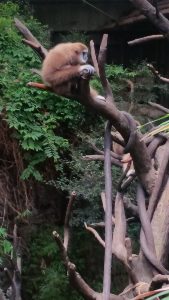
When we walked behind the waterfall we encountered one of my favorite animals, a Pygmy Slow Loris. Just like in the Desert Dome’s Kingdom’s of the Night, the Slow Loris was in a night habitat.
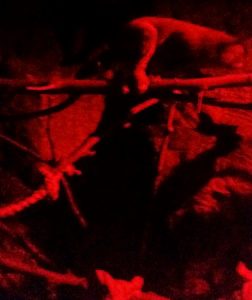
Behind another waterfall were Fruit Bats, they are able to fly all over the jungle (free flying).
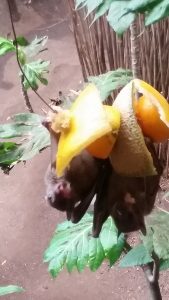
The jungle is also home to the smallest of amphibians, Poison Dart Frogs.
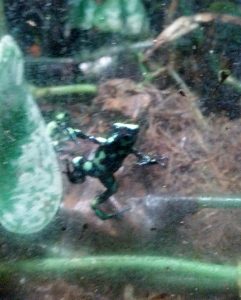
Directly outside the Lied Jungle building is a species that lives in the African forests, the Okapi. The Okapi is the Giraffe’s only living relative.
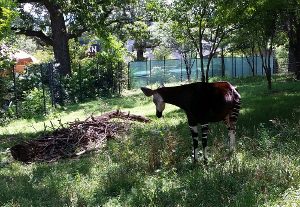
As we were making our way toward the Butterfly and Insect Pavilion we saw a couple of keepers walking an Aardvark on a leash. It kind of made me want an Aardvark for a half second, until I remembered they are diggers.
Only a handful of the zoos we have visited have had some sort of Insectarium. The Insect Pavilion at the zoo is very immersive. It is home to a variety of species including Ants, Spiders (creepy), Scorpions, Walking Sticks, Mantis, Centipedes’, Roaches, Beetles, and a lot more amazing creatures. Did you know insects make up the majority of the animal species on earth? Crazy huh?
After Steve was thoroughly creeped out, we decided to have lunch before we went to see the Primates, Cats, Bears, and Madagascar.
We chose to have lunch at the Omaha Steaks Grill located outside the Lied Jungle. Steve had a burger and fries. I had a steak sandwich and fries. We shared a drink.
Once lunch was finished we trekked to the Hubbard Orangutan Forest. The Orangutan habitat is two stories. To get to the lower level you will need to take the glass elevator or walk all the way around the Cat Complex and come in from the opposite side.
There are two Banyan Trees (manmade) that reach 65 feet in the air. The Orangutans are able to see the entire zoo from that height. This is good enrichment for them to be able to see and study everything and everyone.
Next up we worked our way over to the three acre Gorilla Valley habitat. Two of the three acres are for the Gorillas and visitor space. The way the habitat is set up is the visitors are able to get up close and personal with the Gorillas. If the Gorillas aren’t being shy that day. There are really neat bubbles visitors can stand or sit under which allows you to actually be in the Gorilla habitat with the Gorillas.
One of the male Gorillas appeared rather upset, we couldn’t figure out what was bothering him. Then I noticed a woman was eating ice cream in front of him. In Gorilla culture it is extremely rude to eat in front of the dominant male. Once I realized what was happening, I may have vented to Steve about how rude she was being. I may have also said it loud enough she could hear me. She looked a little sheepish and took a couple of steps away from the window. The male Gorilla quickly settled down.
After leaving the Gorillas, Orangutans, and other primates we strolled through the Simmons Aviary. This incredible exhibit let you see several beautiful species of birds in their natural habitat! You walked along a raised boardwalk inside a massive net. You could see the birds up close with no fence or glass between you. It was a really cool experience.
After leaving the aviary, we went (you guessed it) left into the new Asian Highlands exhibit.
You guys, I am not kidding when I tell you we felt like we traveled to Asia! It was a complete cultural immersion adventure!
As you enter the Asian Highlands, you will find the Red Panda habitat. We overheard the tour guide on the train tell his passengers that if you find the Red Panda, then you win! He was right. The little cutie was hard to find. They can be elusive, and the sleep a lot. So if you do happen to see them, it is an absolute treat!
Up next was the adorable Tufted Deer, the majestic Crane, the regal Indian Rhino, and the mysterious Pere David Deer. As we have mentioned before, these “swamp deer” are extinct in the wild, and it is a treat to see them in such a wonderful habitat. These guys were really enjoying a nice mud bath when we visited. It was hot, and I might not have minded joining them.
From there we visited the Sloth Bear, and Steve cooled off in the Foggy Forest. It was a cute area with tons of misters going off. Steve said it was very refreshing.
I cannot tell you enough how immersive the Asian Highlands were! Everywhere you looked were visual cues helping transport you to the places these animals call home and the cultures that interact with these animals. The architecture, landscaping, and decorations worked together perfectly to make you feel like you were strolling through an Asia mountain countryside.
Also be sure to check out the signs. The signs were both educational AND hilarious!
Finally, you come to the Tiger, Snow Leopard, Takin, and Goral habitats. There were all five paws out of five! These incredible exhibits are just as enriching for you as the visitor as they are for the animals themselves!
Last but not least on the first day, we traveled to Madagascar, Africa. We first walked through Lemur Island located across from the Expedition Madagascar building.
In here we walked along a boardwalk while being surrounded by Lemurs. They have Red Ruffed, Brown, and Ringtail Lemurs on Lemur Island.
We entered Expedition Madagascar, Madagascar is an island off the east coast of Africa, after hanging out with the Lemurs for a while.
Madagascar is home to the largest number of endemic plant and animal species in the world. Some of those species are the Lemurs, Fossa, Giant Jumping Rat, Aye-aye, Sifaka, and about half of the world’s 150 or so Chameleon species.
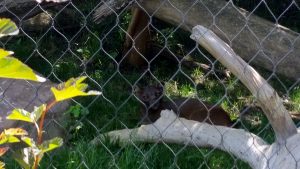
After we were finished learning all we could about Madagascar and seeing all the animals that call this island home, we decided to call it a day.
Once we were back to the hotel we walked across the hotel parking lot and had SPIN! Pizza. It was amazing, they also have Italian Gelato.
Ready to hear about day two? We again arrived at the zoo at 9 am when they opened. This time after we paid our admission we headed straight to Africa.
To get to Africa, take a right when you enter the zoo. It will be the path between the Wild Kingdom Pavilion and the Lied Jungle building. When you reach the Scott Aquarium stay right at the fork. This path will take you past the Skyfari Landing. Past the ticket kiosk, take a left and you will be in Africa.
The huge rock formations you encounter at the entrance and throughout Africa are called Kopjes. They allow predators and prey to have a better view of their surroundings.
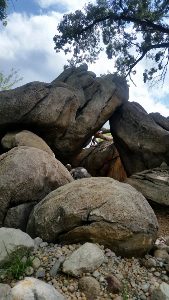
Here in the Kopjes you can encounter Klipspringer and Meerkats. You can also see Rock Hyrax among a few other species native to Africa.
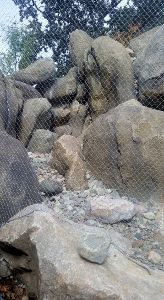
Once you have made your way through the Kopjes, you turn to the left and can see out over the savanna.
On the savanna you can see Giraffe, White Rhino, Ostrich, and Impala. As we walked down the path Giraffe feeding was on our left.
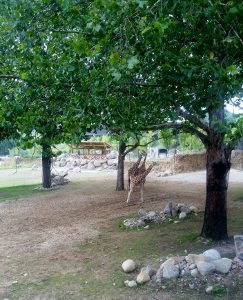
To the right, you can enter the Giraffe Herd Rooms (Giraffe bedrooms), where Giraffes sleep and stay on days it is too hot or cold to go outside. Did you know Giraffe cannot be outside if the temperature is below 40 degrees or above 110 degrees.
A few steps from the Giraffe Herd Rooms is the Elephant Family Quarters. You can also enter this building to see where the elephants spend their nights.
As we walked along, further down the path, deeper into Africa we came upon the African Lodge. The African Lodge has dining tables outside next to the Elephant, Zebra, and Impala savanna habitat.
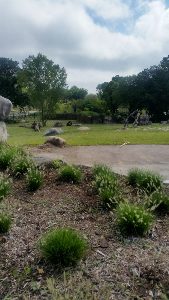
We had our lunch outside and watched the Elephants browse. The African Lodge serves African inspired dishes (after all we are in Africa).
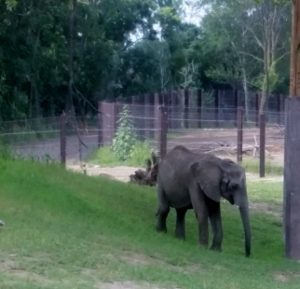
Steve had some kind of stuffed fried meat pie. Sort of like an empanada but African. I cannot remember what they are called. Anyway, they were stuffed with ground meat (beef) and warm African spices. I had their version of a BBQ (chopped beef) sandwich and sweet potato fries. It was delicious.
We sat for a while in the shade and watched the elephants and zebra graze. Once we were all rested up we got up and headed further down the path.
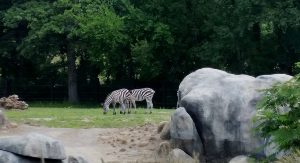
We came upon a lagoon, we had to take a selfie with the giant Mastodon statue nearby. We walked through the Garden of Senses. It was very peaceful. Next we headed over Pelican Lake Bridge and found ourselves in big cat country.
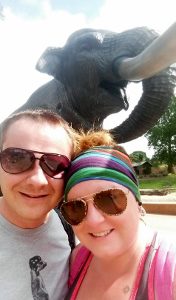
The first cat species we came across was Cheetah. There are two Cheetah in a very specious habitat. They were laying in the shade enjoying an afternoon nap. Occasionally, one of the Cheetah would lift his head to make sure everything in their territory was fine. Did you know Cheetah are the only species of cat that do not retract their claws?
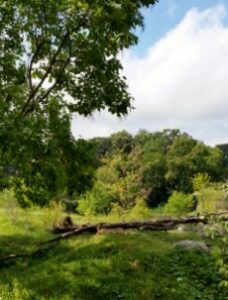
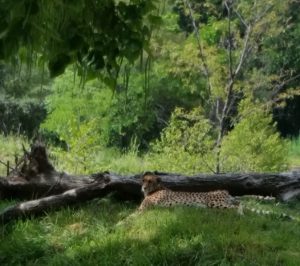
Across the path from the Cheetah habitat is a Kopje, this Kopje allows visitors to go under, around, and climb on top of it.

Behind the Kopje are Bongos (African Antelope), they live in dense African jungles.
Down the path from the Bongo and Cheetah is the African Lion Kopje. This is a very nice habitat for the lions. They have their own cave at the top of their Kopje.
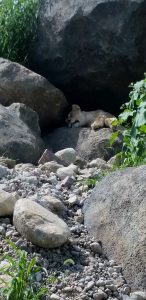
At ground level they have a beautiful pond and a small waterfall (trickle really, but keeps the water fresh).
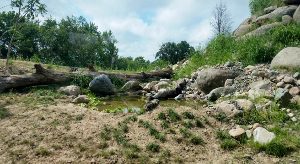
There is a covered (approx. 60 feet of window) viewing area with concrete benches for visitors. Similar to Dallas, they have an old jeep you can sit in. They also have an observation tower for the keepers. This is a great way to check on the pride without disturbing them. The keepers are able to see into the Kopje, where the lions like to nap.
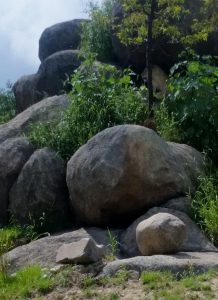
Do you know how to tell lions apart? Aside from the easy male and female differences of course. The way to tell lions apart from one another, when there are no other identifiers is…the spots on their face where their whiskers are. Each lion will have different spots.
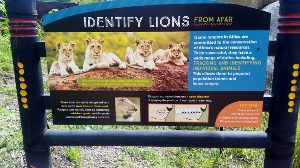
Across from the Lions in this African village is an old helicopter. You can play on and take pictures with it. Also, in this area is one end of the Skyfari. The Skyfari is like a ski lift that takes you over Africa. You can get on or off here.
There is also a Safari camp. Basically, on certain dates you can pay to camp in the tents next to the Lion habitat. How cool would that be? You are laying in your cot and hear the lions call out and roar saying, “This is my territory!” There is information about the Safari Tent Camping on the Henry Doorly website.
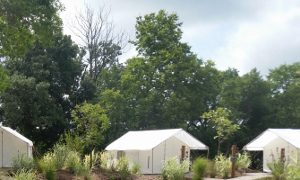
When we left the African Village we saw on our right Sable Antelope. There is another Bongo viewing area to the left.
There are Tortoise habitats on the left as well before you completely exit Africa.
Before we walked back over the Pelican Lake Bridge we encountered Sea Lions. They are in a huge pool with an almost 360 degree viewing area.
When we got to this point in the day it wasn’t yet time to go back to the hotel and get ready for supper (SPIN! again).
We decided we would go back through the Desert Dome and Lied Jungle to see our favorite habitats. We didn’t have to take nearly as long the second trip through.
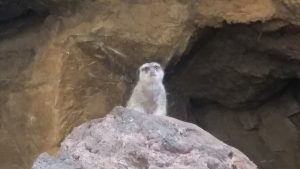
When we finished, we stopped by the gift shop and purchased our magnet. I absolutely loved the Henry Doorly Zoo. Their dedication to cultural immersion, education, and species habitats is wonderful. I am super excited to go back again! Until then, the end!